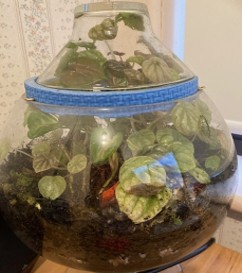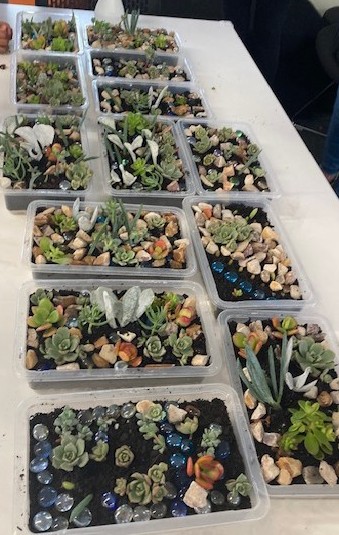Build a Recycled Terrarium
Setting up and Caring for Terrariums
Terrariums are mini ecosystems that support plants to grow and thrive. The name Terrarium comes from the Latin terra (‘earth’) + arium (‘a place or container).
An early type of terrarium was known as the Wardian case, invented by Dr. Nathaniel Ward in London in 1829. Made of glass and lead it was designed to keep plants alive during long sea voyages, since at this time many plants were being brought to England and the Wardian case also protected the plants against London’s smog.
Terrariums work through a cycle of plants and soil releasing water into the small, enclosed atmosphere which is taken back into the plants allowing moisture to continuously circulate. The life span of a terrarium will depend on the amount of sunlight, moisture, temperature, plant selection and container size but can last up to two years or more.

Types of terrariums
While terrariums come in all shapes and sizes, there are two types of terrarium systems.
Closed system terrarium
This is the terrarium type where the container is made of a transparent material usually glass and completely sealed to keep in moisture. In this system, high humidity from plant water vapour causes condensation on the inside of the glass. Humidity loving plants do well in a closed terrarium system if temperatures are moderate and the terrarium is placed in soft light to avoid burning.
How to set up a closed terrarium
To set up a closed system terrarium first create a base layer of sand or crushed stone, this holds any excess water. Then sprinkle horticultural charcoal, the charcoal is fine and helps control mould and bacteria.
The final layer is potting mix, usually around three centimetres but if it’s a bigger glass container you may need to add more as this is what your plant’s roots will anchor itself into, making sure to leave space for your plant to grow. Mulch is not needed, instead surfaces can be decorated with moss, pebbles or even mini statues.
With watering begin with a quarter cup of water to kick off the system. If you see water sitting at the bottom of your terrarium, you have overwatered so start with less water. If you cannot see condensation forming over a couple of days and the plant’s leaves are wilting add some more water. Occasionally you may need to prune out any dead or diseased plants and afterwards close up the terrarium so that it doesn’t dry out.
Some popular plants for closed terrariums are:
Mosses, there are over 20,000 species of mosses. Instead of roots they have filaments called rhizoids. They do well in terrariums as they thrive in high humidity and must be constantly moist so a mister bottle is a must.
Fittonia zerbrano known as Fittonia nerve plant is a spreading evergreen perennial with distinctive, delicately veined, deep green oval leaves and loves high humidity.
Peperomias are popular as their compact shape means they won’t quickly outgrow the terrarium. They are originally from warm humid climates and grow well in a close system terrarium.

Open system terrarium
These containers are open to the air and suitable for succulent plants that can handle drying out.
Open system terrariums should be placed in bright sunlight for up to 7 hours a day but avoid setting them up to close to heaters that can burn the leaves. Only lightly water open system terrariums with a mister bottle every fortnight.
How to set up an open terrarium
To set up a closed system terrarium, first create a base layer of sand or crushed stone, this holds any excess water. Then sprinkle horticultural charcoal, the charcoal is fine and helps control mould and bacteria.
On top of the charcoal use a fast-draining, succulent and cactus mix, or add perlite or gritty sand to potting mix to improve aeration and drainage.
Some popular plants for closed terrariums are:
Air plants, these are native to deserts, swamps and tropical rainforests. They can be grown indoors and don’t have a root system. They prefer a spot in bright, filtered light but avoid hot locations. Water air plants by taking it out of the terrarium and soaking it in room temperature water for 20 minutes, then shake off excess water, dry completely and return the air plant back to the terrarium. Repeat this process 2 to 3 times a week as needed.
Echeverias are rosette shaped succulents that come in a range of colours from white to fire engine red and grow clusters of rosettes that can cover the potting mix creating pretty displays. They thrive in loose soil and dry conditions.
Jelly Bean Plants have tight grape like growths with red and green plump leaves that are sensitive to touch and drop off when handled but grow quickly back.
Graptoverias grow in loose rosettes of plump leaves and come in a range of soft colours. They love full to partial sun for most of the day. Like Echeverias they enjoy loose soil and dry conditions.
Caring and styling your terrarium
Before planting into your terrarium, make sure your terrarium is clean, has an airtight seal and a big enough opening to position your plants.
Choose plants that enjoy the same conditions (such as high humidity) so they grow well together.
Snip off any broken stems or damaged leaves and gently cover any roots in potting mix. When positioning your plants choose contrasting colours and leaf shape adding interest to your terrarium.
Put the tallest plants in the middle to the smallest next to the glass so the planting display can be enjoyed from all angles. Take off any leaves that touch the glass as constant moisture from the condensation may cause fungal infections. Be careful not to overwater your closed terrarium as this can cause rot. However, if you don’t have a lot of condensation give your terrarium a mist.
Be creative
You don’t have to spend a lot of money on terrariums. As long as it’s made from clear glass you can turn old bottles or jars into vibrant plant displays, even old fish tanks. However, check that the glass is intact, has a clear lid and seals well enough to keep your little world thriving.
So why not give terrariums a go and enjoy miniature plant life up close!


